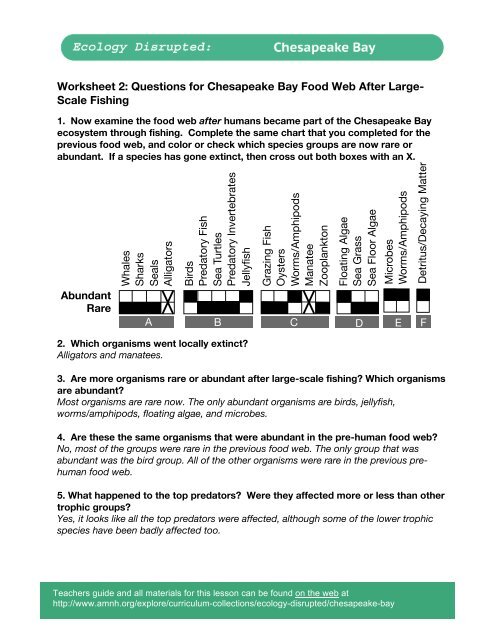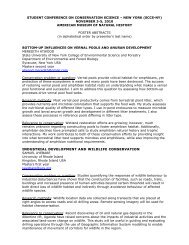Create successful ePaper yourself
Turn your PDF publications into a flip-book with our unique Google optimized e-Paper software.
<strong>Befor</strong>e%A"er%Worksheet 2: Questions for Chesapeake Bay Food Web After Large-Scale Fishing1. Now examine the food web after humans became part of the Chesapeake BayAbundantecosystem through fishing. Complete the same chart that you completed for theRareprevious food web, and color or check which species groups are now rare orabundant. If a species A has gone extinct, B then cross C out both boxes D with an EX.FEAbundantRareWhalesSharksSealsAlligatorsWhalesSharksSealsAlligatorsBirdsPredatory FishSea TurtlesPredatory InvertebratesJellyfishBirdsPredatory FishSea TurtlesPredatory InvertebratesJellyfishGrazing FishOystersWorms/AmphipodsManateeZooplanktonFloating AlgaeSea GrassSea Floor AlgaeA B C D2. Which organisms went locally extinct?Alligators and manatees.Grazing FishOystersWorms/AmphipodsManateeZooplanktonFloating AlgaeSea GrassSea Floor AlgaeMicrobesWorms/AmphipodsMicrobesWorms/Amphipods3. Are more organisms rare or abundant after large-scale fishing? Which organismsare abundant?Most organisms are rare now. The only abundant organisms are birds, jellyfish,worms/amphipods, floating algae, and microbes.4. Are these the same organisms that were abundant in the pre-human food web?No, most of the groups were rare in the previous food web. The only group that wasabundant was the bird group. All of the other organisms were rare in the previous prehumanfood web.5. What happened to the top predators? Were they affected more or less than othertrophic groups?Yes, it looks like all the top predators were affected, although some of the lower trophicspecies have been badly affected too.EDetritus/Decaying MatteDetritus/Decaying MatterFTeachers guide and all materials for this lesson can be found on the web athttp://www.amnh.org/explore/curriculum-collections/ecology-disrupted/chesapeake-bay
6. List how many species groups depend on each of the species groups listed atthe top of this table. Count the number of strong and weak connections (arrowsgoing to or from a species group) to complete the table below:Connection Sea Floor Plants Predatory Fish Grazing Fish Floating AlgaeStrong:Weak:Total:Strong: 0Weak: 3Total: 3Strong: 1Weak: 7Total: 8Strong: 1Weak: 7Total: 7Strong: 1Weak: 1Total: 27. In general, do these species groups have more connections or less after fishing?They have the same number of interactions.8. How does the strength of the interactions compare between this food web andthe one before fishing?Many interactions are weaker.9. What does it mean for the ecosystem when most of the interactions are weak?If means that the complexity of the ecosystem is reduced. There is a lot less going on inthe ecosystem.10. Redraw the food web including only the abundant species? What do you notice?(Note: some species may not have any connections at all)The only part of the food web that can successfully be redrawn is the relationship amongstthe detritus, microbes, floating algae, and worms/amphipods – the very low trophic levels.Higher trophic levels are not included. The complexity of the ecosystem has been lost. Also,people have been added to the ecosystem and jellyfish that were once rare are nowabundant. Some species might not have any connections at all.11. How is this food web similar/different to the food web without people?Similar: Many of the same organisms are still there. They are just much diminished. Birds arecommon in both food webs. Different: Some organisms are now locally extinct like alligatorsand manatees. Many common organisms are now rare like whales, sharks, seals, alligators,predatory fish, sea turtles, grazing fish, predatory invertebrates, zooplankton, sea cows,oysters, sea floor algae and plants, sea grass. Jellyfish are now abundant. People have beenadded to the ecosystem.12. Why do you think jellyfish are now abundant?There are few sea turtles or whales to eat them.13. Why are there fewer predatory fish if there are fewer whales, sharks, seals andalligators?Teachers guide and all materials for this lesson can be found on the web athttp://www.amnh.org/explore/curriculum-collections/ecology-disrupted/chesapeake-bay
People are fishing them to eat too.14. Which producers are now more common in this ecosystem, the floating algaeor the sea floor algae and plants and seagrass?Floating algae are now more common in the ecosystem.15. From what you know about the relationship between high levels of nutrients andalgae growth, why have the floating algae increased?High nutrient pollution (fertilizer) in run off from the land caused an increase in algae that liveon the surface.16. What happened to the sea floor algae and plants? If fewer organisms areeating them, shouldn’t their numbers have increased? Why are they rare now? Hint:Like all plants, what do the sea floor algae and plants need to grow? How do morefloating algae limit this important resource that sea floor algae and plants need?Explain.Thick layers of floating algae block the sunlight from reaching the sea floor algae and plantsthat grow down below. Without sunlight the seafloor algae and plants cannot grow.17. How does this food web connect to the present-day problem of high nutrientlevels in the water? (Hint: Oysters filter the nutrients, microbes and floating algae fromthe water.) Use the food web to explain what happened to their numbers and why.Oysters filter the water cleaning it of microbes, floating algae, and excess nutrients. Peoplefished out the oysters taking away the Bay’s natural filter. Without the filter, the Bay is nowfilled with excess nutrient levels, microbes, and floating algae that would have beenconsumed by the oysters.18. Based on your answer to question seventeen make a hypothesis for howcatching oysters affects floating algae levels?Hypothesis:If people overharvest the oysters, then floating algae would increase in the Bay.People overharvested the oysters leading to an increase of floating algae in the Bay.19. What type of data would you need to collect in order to test your hypothesis?Hint: You would need to compare historic and present day data on two elements ofthe ocean. What are those elements?We would need to have historic and present day data on the number of oysters and the levelof floating algae in the Bay.Teachers guide and all materials for this lesson can be found on the web athttp://www.amnh.org/explore/curriculum-collections/ecology-disrupted/chesapeake-bay
















